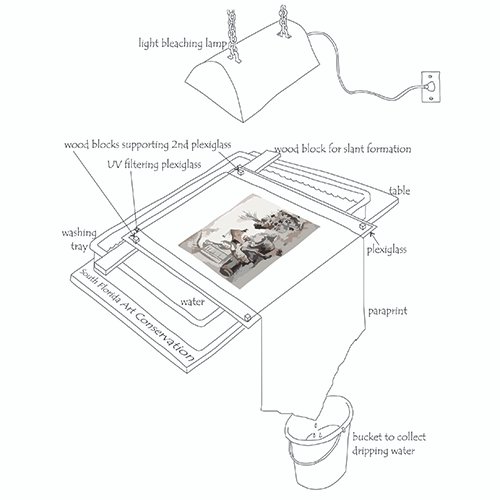Can capillary washing and light bleaching be combined?
As we said in a previous post, with water-sensitive paper objects, the challenge is to remove water-soluble degradation products, while keeping the water-sensitive medium in its place. In capillary washing, discoloration products are removed from the object that lie in contact with the non woven fabric. First through the diffusion of these substances towards the clean water contained in the non woven fabric trying to reach an equilibrium, and then by the continuous water flow/water renovation created due to the capillary or siphoning action of the fibers in the non woven material.
What if the artwork has not only aged and discolored, but there is also a strong mat burn as well? What if this strong discoloration is interfering with the chromatic values of the artwork and the original colors can no longer be appreciated? Sometimes to complete the cleaning process, the conservator needs to go a step further and a bleaching process becomes a necessity to return the artwork to its original balance and to improve its appearance.
Of course, with every artwork, the extent to which it can withstand a bleaching process and to what degree this bleaching can affect the media, needs to be weighted and tested to make an informed decision. In the past, chemical bleaching has been widely used; nowadays these processes tend to be avoided unless the benefit obtained outweighs the risk of the procedure. The same thing does not occur with light bleaching, which, although forgotten for a while, nowadays has become a common practice in the paper conservation field.
But, can capillary washing and light bleaching be combined? I would say yes. There is one caveat: the artwork needs to withstand both techniques. Both, color light fastness and possible bleeding of the media when wetted should be definitely tested beforehand.
For this treatment, the slant for the capillary washing is set under the light bleaching lamp. The process starts with a regular capillary washing. Once most of the discoloration is off the paper, the ph of the water is raised to a 9, This "modified water" is allowed to run down the slant for about an hour to modify the pH of the paper as well. Then, the light bleaching lamp is switched on, so it cleans (or rather light bleaches) the paper further.
To minimize water evaporation at the surface of the paper (which can result in the formation of stains) a piece of plexiglass is positioned "floating" on top of the paper during the entirety of the process. This plexi is like the one used in conservation
framing which filters out 98% of possible UV radiation from the light source (we do not want any color fading during the process, better safe than sorry).
During all of the light bleaching period, the water is still flowing down the slant and the washing is still being carried out, further improving the cleaning.
All in all, capillary washing and light bleaching, the combination of both processes is another weapon in the paper conservator's arsenal. If suitable for the artwork in hand, the results can be outstanding!








6 Responses